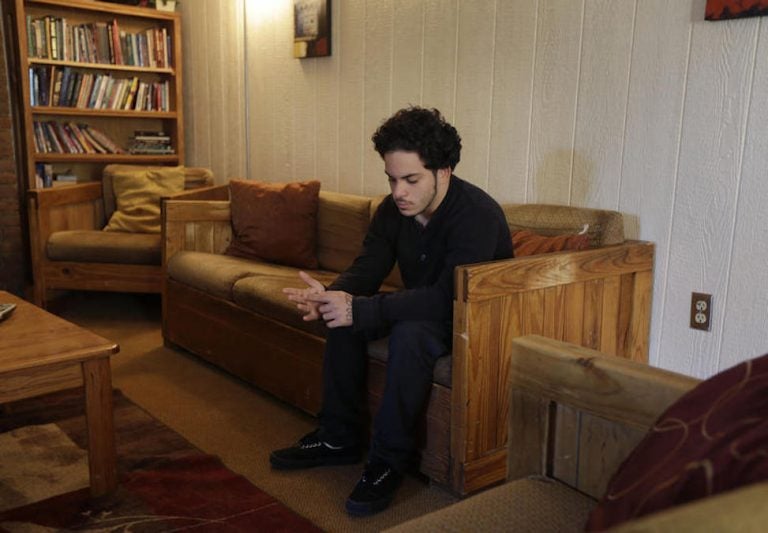Study raises questions about oversight of facilities that house foster youth in Pa.
Foster children who live in residential facilities in Pa. suffered physical and verbal abuse in hundreds of documented cases between 2010 and 2018, according to a new report.

In this Thursday, April 24, 2014 photo, Jose Osario, 20, a resident of the transition cottage, sits in the living room of another cottage at the Children's Village campus in Dobbs Ferry, N.Y. (AP Photo/Seth Wenig)
Foster children who live in residential facilities in Pennsylvania suffered physical and verbal abuse in hundreds of documented cases between 2010 and 2018, according to a new report. The study found that at some facilities, which include group homes and larger institutions, violations continued to occur even after state inspectors recorded earlier instances of abuse.
Report co-author Elissa Glucksman Hyne considers the repeated violations “really alarming” because, she said, they show that children in foster care are “being maltreated by [facility] staff, and it seems nothing is done about it … It’s just business as usual, and nothing seems to happen.”
“No child should ever be removed from their home and then harmed in the places that they are supposed to be placed to be safe,” added Hyne, a senior policy analyst at the New York-based nonprofit, Children’s Rights. “If that happens, then we would hope that something is done about it.”
The inquiry was based on a sample of facilities located mostly in Philadelphia and central Pennsylvania, Hyne said. It included instances of abuse believed to have been committed by staff and other children, with staff accused in over 70 percent of cases.
Children’s Rights released the report with Pennsylvania’s Education Law Center last week, about a month after a separate study showed the state is more likely than the rest of the nation to place foster youth in residential facilities. According to that research, 47 percent of the Pennsylvania’s foster youths aged 14 to 21 live in these facilities, as opposed to with relatives or unrelated caretakers in a family setting. Nationally, 34 percent of foster youth live in residential placements.
In total, last week’s report said, more than 3,700 foster youth in Pennsylvania live in institutional settings, which “range in size from four-bed group homes to over 170-bed institutions.”
Dangers at these facilities, the report found, included physical injury as well as verbal threats of injury. At some facilities, Hyne said, staff punished children by choking them, grabbing them by their hair, and pulling their arms back to the point of pain. The study noted other cases where adults slapped, hit, or punched children.
Limited oversight information
These infractions are allowed to persist, the study found, “because [the Pennsylvania Department of Human Services] fails to adequately license and monitor residential placements in Pennsylvania.”
The department typically inspects facilities that house foster children at least once a year. The report’s authors found that, while inspectors report violations and review facilities’ subsequent correction plans, there’s scant evidence they follow-up to ensure compliance. Repeat violations, they added, further suggest the department does not provide enough oversight.
Spokesman Colin Day said the department is “engaged in a multi-year process” to improve its licensing process and that it plans to meet with the study’s authors.
But, he noted that his agency is “shortening timeframes for … licensing staff to act upon plan[s] of corrections submitted by providers. This also includes assuring timely verification of the plan of corrections.”
Day said the department is also working with the University of Pittsburgh to use predictive analytics “to identify struggling providers before actual harm occurs.”
What the research does and does not show
The findings in last week’s study were based on a sample of licensing compliance reports for nearly half of Pennsylvania’s 541 residential facilities. The reports, which are publicly available on the department’s website, span an eight-year period and number in the thousands, according to Hyne.
In total, the records show children at the sampled institutions were “physically maltreated” 156 times, “verbally maltreated” 43 times, and “exposed to inappropriate sexual contact” 73 times. Inspectors with the state’s Department of Human Services reported the abuse whether it was committed by staff or other children.
The data indicate that staff were responsible for three-quarters of the cases involving physical abuse, and all the cases of verbal abuse. They were about as likely as children to be accused of sexual misconduct.
While the study did not show how Pennsylvania compares to other states, it noted that the number of violations “is likely significantly higher than documented.” It is uncomfortable, the report said, for children to report trauma they experience at the hands of “authority figures who are in control of their living situation.”
Each of the 259 facilities reviewed belong to one of 36 separate legal entities. Within 44 percent of those entities, the study found, more than one violation for physical or sexual maltreatment was documented between 2010 to 2018.
The study acknowledged that it did not randomly select entities for review. Rather, it “focused primarily on facilities that house children from Philadelphia County because it has the largest population of children in foster care. It also “added facilities mentioned … by statewide stakeholders” and located in other counties.
Still, the authors contend that their findings “broadly reflect risks to which many children are exposed statewide as a result of [the Pennsylvania Department of Human Services] patterns and practices.”
Allegheny County, however, stood out as a bright spot in the report. The authors said it has reduced the number of children in congregate care, another term for 24-hour residential placements, by 60 percent between 2012 and 2017. Now, just 5 percent of Allegheny County foster youth live in residential facilities, according to the report.
The county has made such strides in part by “using residential facilities only for children whose needs require such restrictive placements,” said the report’s authors. Instead, the study said, it has placed an increasing number of children with relatives and switched to more community-based services.
“Ideally, that’s what should be happening in every county in the state,” said Hyne of Children’s Rights. “Some children, depending on their stage in the system or their level of need, they may require short placement in congregate care … But there should be a decrease in congregate care because children, at the heart of it, should be raised in families.”
WHYY is your source for fact-based, in-depth journalism and information. As a nonprofit organization, we rely on financial support from readers like you. Please give today.






